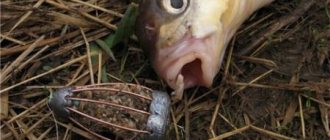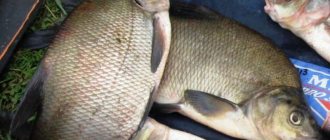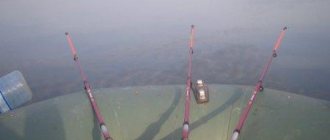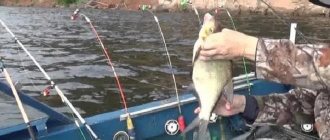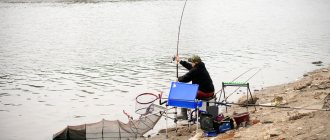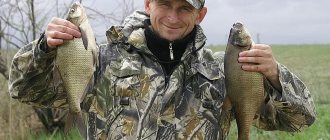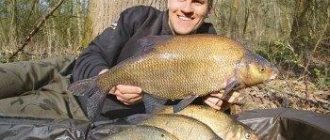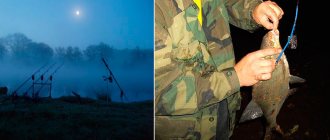Content
- Fishing with rings and eggs from a boat
- How to choose a fishing spot
- Sinker bait. Tackle element
- How to mount leashes
- Choosing hooks for catching bream
- Choosing a fishing rod for catching bream
- Bait for catching bream and ide
- Nozzle
This mega fishing gear was previously banned. It's clear why. Even poachers with nets can envy the catches of the “ring fish”. If you want to learn how to catch really big fish, read this article.
Fishing with rings and eggs from a boat
If you were to ask me what is the most catchy legal method of production I know, I would answer - “on the ring” , also known as “eggs” , also known as underpass . The essence of this method of fishing is simple. A large mesh feeder filled with aromatic bait lures and holds the fish, and several hooks coming from it, just in time, end up on the fish’s table. Simple and very effective. So much so that this tackle was banned for many years. But now there are a lot of bream and ide, nothing prevents you from enjoying stable fishing for large fish. One thing is true, you can easily become a poacher by exceeding the daily catch limit in just a couple of hours of successful fishing.
You can fish from a regular rubber boat, even without a motor. Finding bream sites is very easy for an experienced fisherman; this can be done even without an echo sounder. Usually these are deep holes, channel slopes with a clay bottom, where the current becomes somewhat quieter. Usually bream and ide are in huge schools, so if you set up your gear correctly and find such a cluster, you won’t go home without fish.
There are two main fishing techniques - with a ring sinker and with an egg sinker. The latest, improved method allows you to freely catch large specimens of fish, reducing gatherings. The point is that the wound ring weight constantly slides along the main line going to the feeder, and the eggs “unfasten” when fished out and give more freedom to fight.
Eggs are essentially two ball-weights fixed on a safety pin, the fishing line of the tackle itself slides through the eye, and a cord is passed between the weights, leading to the feeder.
As a child, my grandfather was an avid spinning fisher; sometimes he could not stand the weak bite of a predator in the summer heat and went to the river to amuse himself with ring fishing. I remember the buckets full of bream and ide he brought home from every fishing trip. It’s a pity that the epidemic of opisthorchiasis in the Ob basin did not allow us to enjoy large, fatty and, probably, very tasty hot and cold smoked bream...
Feeder for ring fishing
When the rig is lowered, the ring rests on the feeder, and the leashes with hooks are pulled out onto the bait spot by the current. The first to be fed are the silver bream and the white bream, and after half an hour you can count on the first bream biting. You need to hook a bream confidently; its lips are quite dense and you won’t be able to tear them. After hooking, the angler picks up the main line of the fishing rod and reels in the fish.
A small cage is perfect for a feeder. You can also use special buckets made of metal mesh. The main condition is that the feeder is spacious. About 5 kg of bait should be placed in the feeder.
How to choose a fishing spot
Choosing a place to fish is quite simple. Usually these are deep holes with moderate currents, soft soil, fairway drops, the deepest sections of the riverbed, wintering holes where schools of bream and ide stand. If you have a modern fish finder, this is a fairly simple task to find.
It should be taken into account that fishing with a ring can only be done in the current; this tackle does not work in standing water. For fishing, you should choose places with a depth of at least 4 meters, because large bream and ide are quite cautious fish that are afraid of boats and foreign noises.
Sinker bait. Tackle element
This is a very important element of gear. A well-made feeder is the key to a good catch.
Food should be gradually washed out of the feeder in portions, which will create a trail of turbidity and large fractions, keeping the fish at the point. The intensity of the fish's bite will depend on how your feeder works. Store-bought feeders most often require modifications. They are too light and have manufacturing flaws. A couple of design modifications and you will have an excellent feeder.
The feeder should be heavy so that it falls close to the boat and is not carried several tens of meters. Usually a lead load of about half a kilogram is enough, plus porridge. But it all depends on your fishing conditions, depth and current speed.
Selecting and making a feeder is a very complex issue. There are a lot of designs and shapes, each fisherman customizes it to his own taste. They use steel mesh, nylon bags, stockings, even plastic bottles with burnt holes. You can start with a purchased steel mesh, similar to a small fish tank, modify it and make it heavier, and then, with an understanding of the specifics of fishing, you can adapt and modernize the gear to suit you.
How to mount leashes
One of the common problems of novice fishermen who try to fish this way is tangled leashes. There are several tricks to avoid this.
Use fairly thick fishing lines with a diameter of about 0.3 mm. It is better to use fluorocarbon leaders - this way you will reduce their tangling to a minimum.
- Firstly, fishing for large bream or ide in the fairway current is not an easy task; using thin fishing lines, there will be a lot of cliffs.
- Secondly, the thinner the line, the more easily it will get tangled.
- Thirdly, when fishing at great depths, far from the shore, in a trail of washed-out bait, the fish behaves quite boldly.
A free-floating bait in the water does not alarm the fish. When feeding in the current, the fish does not particularly “click its nose” and does not spend a long time and carefully choosing what to eat. Actively grabs food floating by before it floats out of sight.
The length of the leashes should be 20 cm; you should not make them longer - they will get tangled. And the length of the “entry” itself (the distance from the feeder to the last hook) is from 1.5 m to 3 m. The stronger the current, the longer the allowance. But for your first fishing trips, while you are just learning, I recommend not making it too long.
The video describes in as much detail as possible the manufacture of the correct equipment from an experienced “ring maker”, which will not get tangled.
Choosing a fishing rod for catching bream
A short side duck with a powerful spinning reel will make fishing easier. A nod is used as a bite alarm. It is better not to use bells, because... they constantly get in the way, you have to remove them, which takes time each time and gives the fish a chance to get away.
The main line is made thicker than the leads by 0.1-0.05 mm, about 0.4-0.5 mm is fine. The fishing line on which the ring rides and lowers the feeder is taken about 1 mm - there is no point in thinner.
Tactics for catching bream with a ring
We anchor the boat, across the current, and lower the feeder to the bottom. The ring-weight is put through the cut onto the fishing line on which the feeder is lowered. Next, the bottom itself with bait on hooks (usually I use a worm) sinks to the bottom just to the feeder. Bait washed out by the current attracts fish to your bait. The accuracy of complementary feeding in this option is 100% and this ensures an excellent catch. The bite itself is easy to notice by the tip of the rod, which begins to twitch.
Bait for catching bream and ide
When fishing using this method, you need to pay special attention to bait. The catches of two fishermen from the same place can differ radically if one uses complementary food of the wrong consistency.
Don't be afraid to overfeed the fish when fishing with a ring. It's practically impossible. The bait is constantly washed out and floats away with the current. The fish does not have time to be completely satisfied. And in general, it is almost impossible to overfeed bream and ide.
It is necessary that the bait is well washed out of the feeder and carried by the current. This is the most important principle of operation of this gear. To do this, the porridge should not be too sticky. This is achieved by washing the cereal before cooking. I add fractions that dry and prevent the porridge from sticking - cake, bread. Cake, generally very powerful in aromatics, is an excellent bait, which was used by our grandfathers.
In this case, it makes no sense to use store-bought bait as a basis. Firstly, it is quite expensive because you will need a lot of bait. Secondly, purchased bait consists of rather small fractions, which is not desirable. To interest and attract large fish, you need large fragments - peas, pearl barley and other cereals. Store-bought bait should be mixed into the porridge to add flavor, as an addition, and not as a base. I also recommend trying different aromatic additives. Choose a scent that interests the fish in your pond at this time of year and this will yield an even greater catch.
I don’t see the point in giving an exact recipe in grams. What you have at home goes into complementary food, the main thing is that the main components are present, and that the bait has the correct consistency, and this is best achieved by eye.
Main components:
- millet, cooked until half cooked, when it just begins to open, and washed before and after. So that the bait is more crumbly and does not stick together.
- pearl barley, here you can cook it tightly. Before doing this, it is recommended to soak it overnight. After cooking, rinse.
- peas are also soaked and cooked until almost fully cooked.
- hmyh, added to the finished mixture.
- bread.
- purchased bait to give a better aroma.
You can add rolled oats, but it makes the bait more sticky. Use dry kvass, breadcrumbs, add animal food - maggots, chopped worms, gammarus (smelly aquarium food, which many consider the secret ingredient). Use flavors that the fish in your pond prefer. At worst, use unrefined sunflower oil!
Competent bait is like a chef’s dish; understanding comes with experience and skill!
This video shows ring fishing and also gives the correct bait recipe.
And here is another good video on how to make a tackle ring with your own hands. Enjoy watching.
Catching bream with a ring from a boat
Nowadays, catching bream with a ring (another name is with a puck) is quite common; this technique is practiced on the East European Plain; fishermen of all major rivers have appreciated its advantages. It has taken root not only in Russia, but also in Poland, Belarus, and Ukraine. The method is ancient. Convenient for cyprinids in general, not just bream.
Although there is an opinion that the invention is not of Russian origin, but came to us from Europe. Thus, ring fishing is known in Italy, and there this method was called Florentine (from “Florence” - a city historically associated with fishing).
Be that as it may, the efficiency of the method is incredibly high, approximately at the feeder level. In terms of catchability, it even surpasses it (this is the opinion of many knowledgeable fishermen). Basic principle: It is important that the size of the feeder is large enough. A spacious container will allow the bait to “work” for a long time. After all, a bait that is attractive to bream is placed in the feeder, which after some time begins to “wash out” from the feeder, rise against the main current and spread around.
Boat position when fishing for bream
The insatiable bream is attracted by the treat and rushes towards the food temptation, where it finds the fatal bait on the hook. In terms of production volume, catching bream with a ring using a large feeder will please any fisherman and will bring tens of kilograms of catch! It is not surprising that in some regions fisheries protection services pay close attention and control to it and equate it with commercial fishing. Accordingly, the size of the feeder and the number of hooks used are limited at the legislative level.
Here is a list of everything you need when catching bream with a feeder:
- Actually the feeder itself (container with complementary foods) and the weight that weighs it down.
- Nourishing bait.
- A comfortable rod with a fairly rigid nod.
- “Main” fishing line (with a diameter of 0.35–0.40 mm).
- “Additional” fishing line (with a diameter of 1.0-1.5 mm) and/or nylon cord instead of fishing line.
- Don't forget to prepare leashes from 0.2–0.35 mm fishing line. Optimal length 40–50 cm; hook sizes from 6 to 9.
- Take fishing line 1.0–1.5 m long for leashes with a diameter of 0.3–0.35 mm.
- And, of course, the most important thing is a boat with an anchor.
And now in more detail. The feeder can be made of anything, most often a mesh bag is used (remember, in Soviet times they were called “string bags” - this one is perfect if you still have one). Or a mesh bag for storing potatoes. Someone uses a bag woven from a mesh washcloth. The point is this: the cells are sufficient (about 5x5 mm) so that the food slowly comes out, but is not washed out quickly. By size: the complementary food should be enough for the entire fishing period, so it is important that the capacity of the feeder ensures long-lasting feeding.
Feeders for ring fishing
On the eve of catching bream on a ring, fill a mesh bag (feeder) with pre-prepared bait and tie it. Attach a ring sinker with leads to the bag. It is not difficult to make - a heavy metal like iron or lead, weighing about 1 kg, will do. The point is to provide stability to the feeder in fast currents. Take care of the special “stopper” at the neck of the bag. It will help avoid tangling the fishing line that holds the feeder and the main fishing line with the ring.
Now regarding the bait. It’s your choice here - experiment at your own discretion. But it is desirable that the food consist of large, medium and small fractions. Accordingly: pearl barley or corn; millet cereal; semolina. There are many recipes, if you don’t want to take risks, try this one first: (with this mixture, catching bream with a ring is guaranteed to bring results):
- Soak the peas and pearl barley in advance and let them swell well.
- Take in different parts a mixture of peas, pearl barley, millet, barley, chaff, semolina, bran, corn grits (hominy).
- Fill the mixture with water in a ratio of 1:2.
- Cook until the water has completely evaporated, remembering to stir.
- Cool.
- Add crushed stale bread (or breadcrumbs).
- A little anise oil (5-10 mg is enough), or a couple of tablespoons of vegetable oil.
- Mix thoroughly until completely homogeneous.
In its softened form, the shelf life of such a mixture is no more than 1 day; if necessary, freeze it in the freezer. And when you fill the feeder, cover the bait with bread crusts, then it will wash out for a very long time and gradually. Weight the feeder with a bag of sand or gravel, or cobblestones, bricks, etc. - either put it inside the bag or tie it to the outside. If only the bag held steady in the current.
Let's talk about thick fishing line (cord) - make a convenient reel to wind the material with the necessary reserve. The fishing line is connected to the weighted feeder with a strong tightening knot. With a diameter of 1.0–1.5 mm, it is convenient to work with the feeder: lower it together with the load into the water as much as necessary, and lift it back up. Tie the entire resulting structure to the boat and immerse it in the water. Keep the line taut. The neck of the bag should be in the water, the bottom of the weighted bag should lie on the bottom.
Ring equipment with feeder
Now let the food spread calmly downstream. And while the voracious bream is attracted, in the meantime you and I will take care of the gear. Let's start with the rod. According to different fishermen, it is convenient to fish for bream with a ring using different rods. Most often, no more than 70 cm is used, used for winter fishing. There seems to be no categorical advice here, see according to your convenience. The main thing is that the nod is sufficiently rigid and does not give in to the current. If we talk about “Italian” equipment, a feeder rod is a must. Some fishermen do without a rod; it is more convenient for them to hold the line directly in their hand and at the same time react quite sensitively to bites.
As mentioned above, the thickness of the main line is 0.35–0.40 mm (extreme limits 0.3–0.5). You will need it no more than 15 meters. The same ring is attached to it, from which, in fact, ring fishing gets its name. To make the ring itself, you will need a round piece of lead. Carefully cut its ends at an angle (about 45 degrees). Fold the ends over until they fit tightly together.
Opposite the resulting joint in the ring, make a small hole (literally 2–3 mm). Thread a fishing line there with a winding ring (swivel) at the end. Leashes, in turn, are attached to the winding ring. Next, onto the fishing line securing the feeder, through the joint of the lead ring, thread the ring with the main fishing line. Immerse the entire resulting structure in water. The ring will slow down and stop as soon as it reaches the feed bag. Using the main line you can adjust the distance between the bag and the hooks.
Ring fishing tackle
As for the boat. Surely you will have a question: what should it be made of? Basically, it doesn't matter. But since ring fishing from a boat requires increased silence, since it is carried out almost under the boat itself. Rubber makes a lot of noise, so it makes sense to choose metal or plastic. It is easier to move silently along their bottom. You definitely need to have 2 anchors - both are powerful enough so that even in strong currents the boat can be held without problems.
Regarding the length of the rope, everything is extremely simple. Estimate the fishing depth, multiply by two, this will be a sufficient length - you are guaranteed to anchor, and if the rope is short, the anchor will “jump” along the bottom to no avail. And, of course, do not forget about the strength of the rope, as well as the reliability of all other accessories.
So, the technical preparation is completed. It's time to think about your fishing strategy. Firstly: where to fish and how to determine where the hunt will be generous with the trophy. Taking into account the “psychology” of bream, the fisherman must set himself a task: to lure the desired fish to the feeder along the feeding trail. And this can be done ideally if you place your base 10–15 meters above where the fish are staying. Since you can’t really see anything through the water, and intuition is a capricious friend, it is recommended to use an echo sounder - listen to the water column, look for a suitable hole, over which to stake out.
Secondly, how to catch. In general, the technique of fishing with a ring is quite clear, just follow the sequence of actions. First, place bait on the hook. Which one? The worm, of course, has no competition. No worm - feel free to use corn or pea kernels. They also work well. Now put the ring on the fishing line (rope) that holds the bag of bait. Slowly lower the bait with a load to the feeder smoothly, do not rush. It is appropriate to twitch the line slightly if you do not like to passively wait for a bite. If you want to activate the bite, it is advisable to twitch the feeder.
[ratings]
Nozzle
Here the choice depends on the specific body of water and time of year. You need to have several bait options with you so that while fishing you can determine the most catchy one and make a “sandwich”. Usually these are worms - dung worms (California), crawlers and maggots. Foam balls are like the most unpretentious attachment. Less often dough. Dough is generally an inconvenient thing for this method of fishing, because... fishing always takes place in a moderate current, it is washed away and does not hold well on the hook. And although this is a very good attachment in summer, if you do not know how to make very tight, dense dough that will stay on the hook for a long time, it is better to abandon this idea. It's great if you can get a lot of cockchafer larvae - this is a good bonus for trophy ulcer and bream!
The bait selection tactics are very simple. Usually 3 hooks are used. On the first one, which is closest to the feeder, foam is placed; it will work well here too in the cloud of turbidity from complementary feeding. Next is the worm, maggot. We fix what gets the most bites and equip the rest of the hooks with this.
If you follow the simple rules for the correct installation of gear, learn how to make proper bait and find a place where carp fish stay, your catch will always be guaranteed!
Please share the intricacies of fishing in the comments if you have mastered this gear perfectly. Thank you!
NHNCH.
Nozzle and bait when fishing with a ring
When fishing with a ring, you can use a worm, maggot, dough, lard as bait, even a fry or a piece of fish; even a pike perch or catfish can bite. The remains of old bread are used as bait. If not available, use crackers, a variety of cereals, cakes, which can be flavored; there is a wide field for experimentation.
Personally, in my own practice, I was convinced of the catchability of this gear, so I advise everyone to try fishing with it.
- share
- share
- share
- share
- tweet
- share
